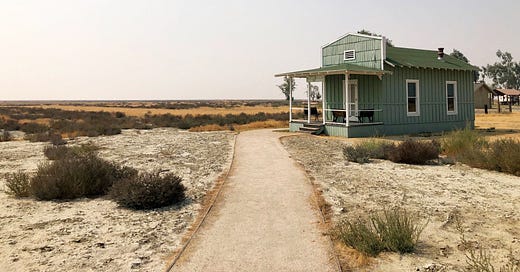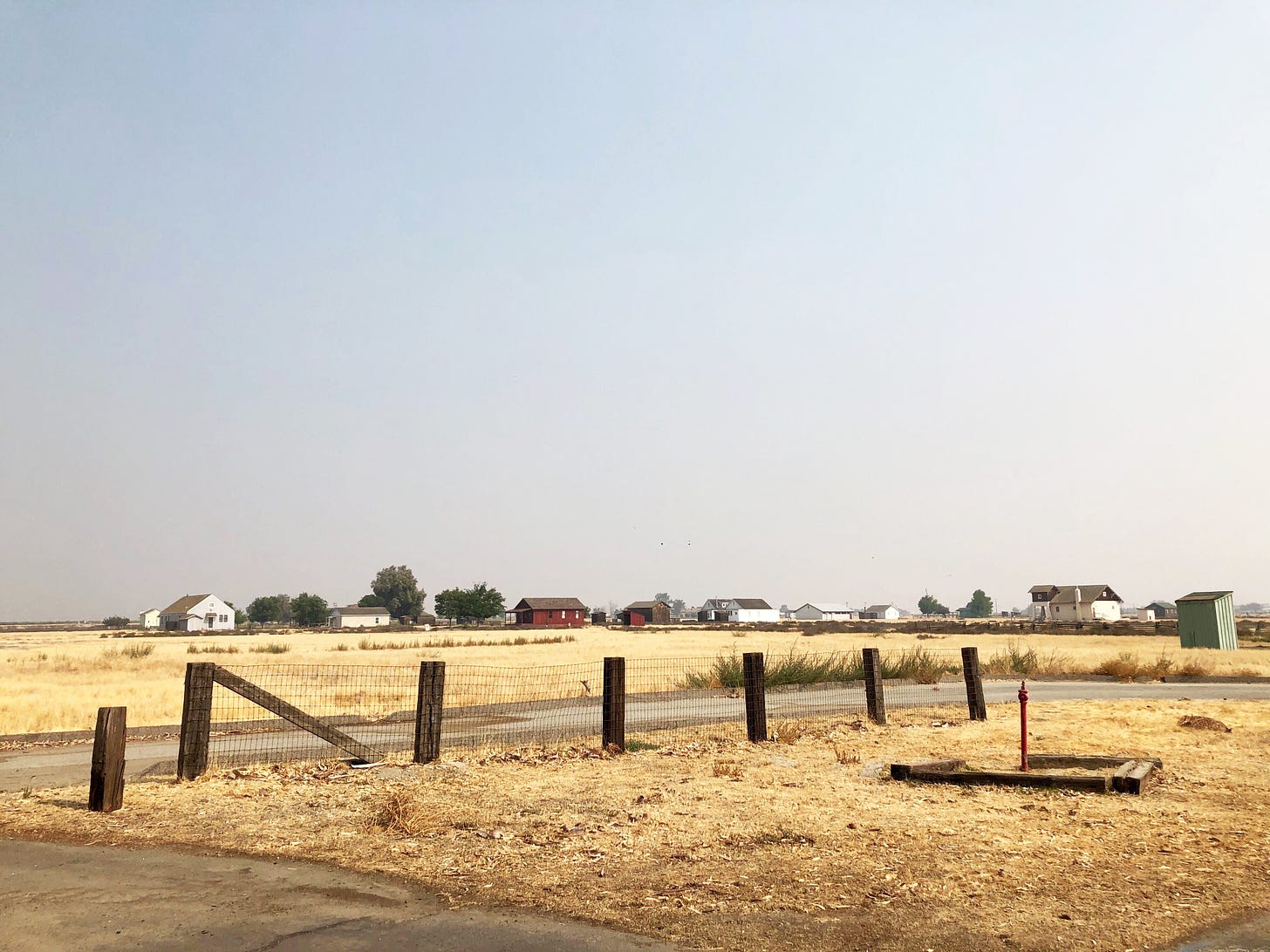A Visit to the California Town Founded by Black Americans
At the start of the 20th century, a small group of Californians built a new kind of community.
California is full of ghost towns. Usually, the eerie ruins serve as monuments to the boom and bust of the Wild West—abandoned by Hollywood production studios or residents in search of better livelihoods or a more reliable water source. Whatever the particular circumstances, most are haunted, either literally or figuratively, by the specters of failed industry.
Allensworth is a ghost town of a somewhat different variety. The town—located about two-and-a-half hours northwest of Los Angeles—was founded in 1908 by Colonel Allen Allensworth, William Payne, John W. Palmer, William H. Peck and Harry A. Mitchell, five Black men who sought to create an independent and self-sufficient community. It was among the first (if not the first) towns in California founded, financed, and governed by Black Americans.
Allensworth was an Army chaplain and orator. Born into slavery in Louisville, KY, in 1842, he fled at the age of 20 to join the Union Navy and was honorably discharged as a chief petty officer. He went on to earn a doctorate in theology, was ordained as a Baptist minister, and in 1886, he became the Chaplain of the 24th Infantry, one of the army’s four Black regiments. In 1906, Allensworth retired as a lieutenant colonel, the first Black man to attain such a rank.
The founders of Allensworth chose the location because it was affordable, seemingly fertile, and was positioned along the Santa Fe Railroad. In its first few years, Allensworth garnered a great deal of interest and press, with (deeply dated and bigoted) headlines from around the country like: “Negro Colony at Solita Prosperous,” “Allensworth Folks Great Readers,” and “An Ideal Negro Settlement.” By 1910, Allensworth had a small school, and by 1912, a population of 100 people. It went on to become a judicial district and a voting precinct, and part of the regional library and school systems, with its own constable and justice of the peace.
But in 1913, the town’s upward trajectory hit a major, and well-trodden and aforementioned stumbling block: water. The exact details surrounding Allensworth’s water supply issues are nebulous, but reports suggest that the former landowners, Pacific Farming Company, tried to rob the residents of their water rights and failed to provide the town with a water system. Meanwhile, water was being diverted to other, whiter communities and Allensworth couldn’t afford to dig another well. By 1914, the groundwater table had dropped considerably. The water supply would continue to plague Allensworth for decades to come and in 1966, state water officials discovered arsenic in the town’s wells.
Just as water was becoming a crucial problem, The California Eagle reported that Allensworth had expanded to 900 acres of land worth over $112,500. It had also reportedly grown to more than 200 inhabitants. But it wasn’t just water that halted the town’s growth. In July 1914, the Santa Fe Railroad moved its rail stop from Allensworth to Alpaugh—just seven miles away, but enough to cause a huge economic blow—and a move fueled by racist farmers who didn’t want to encounter the residents of Allensworth. Then, in September 1914, another huge setback: As he was getting ready to preach at a church in Monrovia, CA, Allensworth was struck by a motorcycle and killed.
A great decline followed. With the ever-plummeting water supply and a meager return on crops, persistent drought, and a larger economic slump in the aftermath of World War I, Allensworth’s residents began to seek a better life elsewhere. By the early ‘70s, the population was down to nearly zero and Allensworth disappeared from California maps—that is, until 1974, when California State Parks purchased the land and turned it into Colonel Allensworth State Historic Park (despite some grim, but predictable opposition).
Today, Allensworth exists within the kind of inland California environment that’s hard to describe unless you’ve been there. It’s located just State Route 43, a two-lane highway that stretches for miles and miles through flat farmland, and not much else. The park’s buildings are all either restored or reconstructed, with everything from homes to a barbershop to a Baptist church, and plaques providing detail and historic color.
The day I visited (August 24th), it was 108 degrees and wildfires were, and still are, ravaging California. Even hundreds of miles away, the smoke was inescapable, which is something you can see in the photos below. The heat and air quality were so unbearable that we opted to drive from building to building to look around, and even spoke to a ranger from our car; she said she preferred to have us navigate with the comfort and safety of a vehicle.
The site is a powerful commemoration of the legacy of Allensworth—and is aided largely by volunteers—but the official reading materials provided by the park did leave something to be desired. (Just one of the many ways our government-run parks system fail us.) A brochure awkwardly describes Allen Allensworth as “intelligent and eager for knowledge.” Online, language like “this unique town dedicated to the dignity of the human spirit” and “the courageous group of families and individuals who believed they could create their own version of the ‘American Dream’” feels euphemistic at best, and insulting to the truth of the town and its people. The closest they get to saying something more truthful is: “He [Allensworth] had seen many African Americans move west after the Civil War to escape discrimination. With four other men with similar vision, Allensworth decided to establish a place where African Americans could live and thrive without oppression.” The town’s decline is often framed as a result of an “unavoidable set of circumstances” beyond the control of its residents. That’s true, but it would be more accurate to call it racism.
It’s unfortunate too that there isn’t more to be found about Allensworth the man. Despite the many accounts of the town and Allensworth’s backstory, there is sadly very little left of his words or beliefs. He was reportedly a big proponent of Booker T. Washington’s philosophy of Black self-reliance and found inspiration in the Tuskegee Institute. In an article for New York Age, before founding Allensworth, he wrote:
“A great deal has been said and written about the causes that operate against our success in competing with the white man for an equal chance in the race of life, but the writers and speakers overlook the fact that we are handicapped by weights that we alone can remove. We are continually complaining of what we call color prejudice and charging our individual failure to that cause, without taking into account existing conditions and facts. It is a condition that we are to deal with and not color; true, color and features indicate us as the subjects of this condition. This condition has been brought about by permission of public opinion; all the laws against us are merely public opinion in legal forms. To change these laws we must change public opinion by meeting its demands. Public opinion refuses to enforce laws upon the statute books made for our protection, but enforces those made against us and when an appeal is made to the Supreme Court of the land, by us, it decides against us because of our condition. What are we to do? Educate public opinion.”
I would love to know how Allensworth’s views might have changed (or not) with time, and whether the town he helped establish could have survived if only he himself had lived longer. Despite its faltering, Allensworth became known as “the town that refused to die.” It remains a symbol for many of the volunteers who help keep it alive—full of ghosts but far from a ghost town.
Photos by Caitlin Schneider
This post is part of Discourse University, an occasional series where we tackle history, ideas, and any other wonky kind of thing that strikes our fancy.








Growing up in California, I have never heard of this place or the story of it. Wonderful write up
Caitlin, this is a great story! I've lived in CA for 49 years and have never heard of this place...not in one history book, not in studying CA history...nowhere. I appreciate you bringing this place to light. I drive up the 99 from time-to-time. I'll need to take detour the next time around.